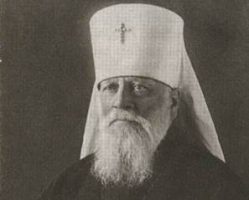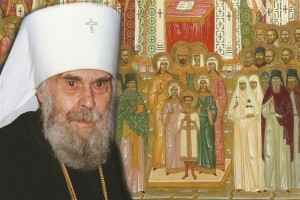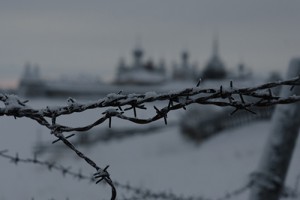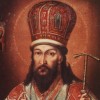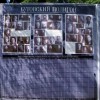Metropolitan Vladimir (Bogoyavlensky)
01. 01. 1848 – 25. 01 (07.02) 1918
Metropolitan Vladimir of Kiev was the first hierarch- martyr of the Russian Orthodox Church during the Bolshevik terror. At first glance, his life seems so simple that nothing in it foreshadows his martyrdom. Yet this is a superficial impression. Martyrdom for Christ is a kind of selectness, one must be worthy. Due to the extreme modesty of Vladyka, many of his feats are hidden and only fragments of his pastoral teachings reveal his spiritual state, the prelude to his Christian end.
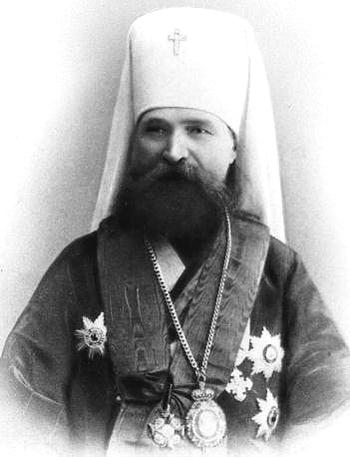 “Not to me, oh Lord, but unto Thy name be the glory!”
“Not to me, oh Lord, but unto Thy name be the glory!”
In the notes of Metropolitan Vladimir addressed to his congregation, especially to the younger generation, humility is one of the main themes: “To be humble means to know nothing about our talents or any other benefits we have above others, but rather consider them to be the grace and gifts of God, and not place ourselves above others, meekly endure insults and abuse, subordinate our will to the will of those standing above us, <…> not strive to show off and distinguish ourselves, but rather worry about the benevolence of God. This is true Christian humility. This is loyalty to Christ”. [1]
His Grace himself knew this way of belittling oneself before others in order to acquire the discreet but precious properties of Christian character – love, humility, compassion – that begin the path of humble suffering for the sake of Christ.
The future hieromartyr was born in 1848, the son of a village priest in the Tambov province, in which priesthood was as a matter of inheritance. However, he was in no hurry to become ordained. After seminary, he studied at the Kiev Theological Academy and for seven years after graduation he remained Vasily Nikiforovich Bogoyavlensky, preparing himself for ordination while teaching homiletics, liturgics, and pastoral theology in the Tambov seminary. At 34, he feels ready for ordination. At this time of his life there is no rush to highly establish himself, as well as no striking demonstration of abilities given to him. There is only labor in his assigned place and the bearing of responsibility before God and respect for others – his family and students. What he writes in his teachings about humility completely reflects his inner spiritual state: “The humble man always has a correct relationship with God. <…> Not to me, oh Lord, but unto thy name be glory! <…>By the grace of God I am what I am” [2]. And perhaps father Vasily would have served until his very death as a priest in a quiet corner of provincial Russia like Kozlov, pleased and very happy with life, if not circumstances beyond his control revealed God’s different plans for him. In 1886 he suffered two trials: as soon as he lost his wife, he parts with their joy – their only beloved child. At age 38, his worldly ties dissolve, and becoming a monk is the natural “refuge” for his humble, God-fearing soul.
When tonsured he was given the name of Vladimir, as if in sign of his future glorification of the Kiev cathedra. His character, knowledge and training drew the attention of church hierarchy. He took on his ministry as a bishop as calmly and willingly as he took priest ordination, not seeking benefits for himself, but relying on Divine will and the established time for each spiritual stage. In 1888 he became bishop of Staraya Russa, vicar of the Novgorod diocese, three years later he was appointed to Samara, then to the Caucasus, and finally in six years to Moscow. From 1898 to 1912 Vladyka Vladimir served the Church as Metropolitan of Moscow and Kolomna. These were difficult years. A great ordeal were the revolutions of 1905 – 1907 and the Moscow “rebellion”.
The personal qualities of Metropolitan Vladimir fitted in Moscow, which was more open and people-friendly compared to the capital. He was remembered as humble, not aspiring to stand out, be praised, and for the fact that without publicizing himself, he helped the poor, fearlessly visited workers in the factories, simply conversing with them about their lives and the then- fashionable socialism, about the possibilities of reform and how to remain a Christian in a foreign urban environment. His Grace did not hide his belief that the popular social theories embody serious moral substitutions. His authority in those years was very great.
In 1912, after the death of Metropolitan Anthony, he was transferred to St. Petersburg. His three-year ministry in the main cathedra of Russia coincided with the beginning of World War I and was complicated by political factors and heated passions around the figure of G. Rasputin.
At that time, even people loyal to the royal family took opposite behavioral positions under the prevailing circumstances. Some believed that any attention to Rasputin, whatever its motives may be, is “on hand” for the opposition and promotes political destabilization [3]. Others, among them – Metropolitan Vladimir, the Grand Duchess Elizabeth Feodorovna, the Dowager Empress Maria Fedorovna – were convinced of the need to remove Rasputin. Metropolitan Vladimir frankly expressed his point of view. Unfortunately, two people, two honest and noble natures could not reach an agreement. Alexandra, partly for fear of slander, partly out of conviction that the family can have “personal friends”, did not take notice of warnings in the form of “indisputable facts” or “general opinion” [3]. In 1915, Metropolitan Vladimir was transferred to Kiev.
“Slaves of false honor”
If humility exalts, then pride humiliates. “Look at the proud” – advises the holy hierarch in his writings – “filled with such pride; often not based on anything actual, how arrogant and conceited he is in his words and deeds, in his movements and mannerisms, his gait, and in his dress! <…> Oh, pitiful vanity! And this is called greatness? No, this is all unknown to the humble man, and he looks with regret at these slaves of false honor” [5]. In his final years, Metropolitan Vladimir will experience much grief and eventually be killed by people caught in the whirlpool of evil: self-affirmed “hierarchs” and self-empowered “authorities”.
In the fall of 1917, Vladyka Vladimir receives threats and insults from the spontaneously organized “church government” – “Supreme Council of Ukraine”, whose members took advantage of political events (proclamation of the Ukrainian State) for the destruction of canonical unity with the Russian Orthodox Church. Commissars of the council were sent out to all corners of the country to forbid church commemoration of Patriarch Tikhon, who was chosen at the All-Russian Local Council. Nationalists demanded the language of the services to be Ukrainian, and they sought to seize churches, including the St. Sophia Cathedral. In Kiev, a rumor was spread that all parish funds are in the hands of Metropolitan Vladimir. The hierarch was put in conditions of isolation in the Kiev-Pechersk Lavra, and his brethren were provoked against him.
The tension continued to rise during autumn, and in the new year of 1918, Kiev began to be torn apart by civil war. Fire in the city did not cease night and day: shells cracked, the deafening shots caused walls and roofs of houses to cave-in. The greatest destruction occurred in the areas of the Kiev-Pechersk Lavra and its rampart. By this time, under the influence of the self-authorized council, the discipline of monks fell so much that when on January 23 Bolsheviks entered the Lavra, nobody even tried to resist: the monastery gates were open and a group of10-15 people freely roamed within.
The situation became extremely dangerous for Metropolitan Vladimir. In this uncontrolled situation he expected any provocation, and even wrote a will in case of sudden death. He celebrated his last liturgy on Sunday, January 21st, and all following days he prayed at home. Then it was Friday, January 25. In the evening a group of armed men headed by a sailor-commissar entered the monastery. Supporters of the nationalists showed them the location of Vladyka’s apartments. Lavra “soundly slept” and no stood up for the 70-year old elder.
According to the hierarch’s cell attendant, the outlaws walked through the rooms, demanding “church capital”, and finally attacked the Metropolitan – ripped of his panagia, choked him with his cross chain and twenty minutes later threw out into the cold and led towards the Lavra rampart. Vladyka went to his death humbly, meekly, crossing himself again and again … Friday night, “sleeping disciples”, and Christ-like loneliness in his grief – this was the hierarch’s measure.
They stopped between Lavra and the military Cathedral of St. Nicholas. Then a shot rang out in the night … Not the monastery brothers, but rather women hurrying to the morning service became the first witnesses of the hierarch’s martyrdom. Metropolitan Vladimir was lying in the snow only in his underclothes. On his body were multiple bayonet and bullet wounds.

The Cross mounted on the place of execution of Hieromartyr Vladimir of Kiev
There was so much suffering ahead that the martyrdom of the Kiev Metropolitan, which shocked not only believers, but also the secular people of Russia, will only be the first chord nationwide drama [6]. In Kiev alone, during such sixteen “extreme situations” at least 12,000 people will be murdered. [7]

Head of the Kharkov KGB, S. A. Saenko.
Official statistics of the Bolshevik terror – in this case, all best-known researchers agree[8] – do not reflect the actual number of victims, nor the horror of torture the victims of the secret police were subject to [9].

Vera Grebennyukova (“Dora Evlinskaya”) – female executioner of the Odessa Cheka.
After the terror and terrible famine that killed millions of people all over Russia, no one will raise the voice against the terror. In the silence of the people, where the Tsar, priests, bishops are murdered, where the covenant with God is dissolved, there evil comes into force. By God’s permission, “the Gethsemane night” will not pass the people of all social classes, ages and professions…

Relics of the hieromartyr Vladimir of Kiev in the near Caves of the Holy Dormition Kyiv-Pechersk Lavra
Translated from the Russian
1. From the book of Hieromartyr Vladimir, Metropolitan of Kiev and Galich, Pastoral conversations with children (quoted from: Hieromartyr Vladimir, Metropolitan of Kiev and Galich / / Warriors of Christ. Lives and works of 20th century ascetics. 2007 calendar. Moscow, 2006. Published by the blessing of Bishop Daniil of South Sakhalin and the Kurile. pgs.39-40).
2. From the book of Heiromartyr Vladimir, Metropolitan of Kiev and Galich, Pastoral conversations with children (quoted from Warriors of Christ. Lives and works of 20th century ascetics. Calendar. p.41).
3. For example, this was the point of view of the Holy Synod’s Chief Prosecutor, prince N.D. Zhevakhov, who emigrated after the revolution.
4. The question of whether G. Rasputin exerted a positive impact on the Tsarevich Alexei during illness exacerbation cannot be completely resolved. Cases of pain relief after his prayers were testified by the emperor’s sister Olga Romanova, who had very little sympathy for Rasputin. The Grand Duchess was rather skeptical and sarcastically evaluated attempts to explain these occurrences as “random coincidence”. (See: Mother and Son. Empress Maria Fyodorovn and Tsar Nicholas II. U.V. Kudrina. Parish of the church-chapel in the name of the Kazanskaya (Peschanskaya) Mother of God in Izmailovo, Moscow. 2004. pgs.51- 52, p. 66). Olga also says: “… Nor my brother, nor Alix believed that this man had supernatural powers. They saw him as a peasant whose deep faith made him an instrument in God’s hands only to heal Alexei. Alix suffered terribly from neuralgia and sciatica, but I’ve never heard that this ‘Siberian’ helped her”. (quoted from: Mother and Son. Empress Maria Fyodorovna and Tsar Nicholas II. U.V. Kudrina. p. 67).
5. From the book of Hieromartyr Vladimir, Metropolitan of Kiev and Galich, Pastoral conversations with children (quoted from Warriors of Christ. Lives and works of 20th century ascetics. Calendar. p.41).
6. A period of “red terror” began in the country. This concept is discussed to this day. The “red terror” is understood not only to be mass repressions carried out by the Bolsheviks in Russia’s civil war (the “red terror” of the 1920’s and the “great terror” 30’s must be differentiated), but also government politics, i.e. political terror. The main feature of this terror is violence against the civilian population.
7. This number is brought forth by U.V. Kudrina and well-known historian of the Russian Civil War S.M. Melgunov (See: Mother and Son. Empress Maria Fyodorovna and Tsar Nicholas II. U.V. Kudrina. p. 184; see also: There was none more vile and mean … U.V. Kudrina/ / Chronos. Russian national philosophy in the writings of its founders: http://www.hrono.ru/statii/2006/kudr_yu.html).
8. See: Red Terror during the Civil War: In materials of the special investigation commission of the Bolshevik atrocities. Edited by U. Felshtinsky. Published by: Terra-book Club, 2004.
Cheka / GPU: Documents and Materials. Felshtinsky. U.G. Publishing house of humanity literature, 1995. Red and White Terror in Russia, 1918-1922. Litvin, L.A. Kazan, 1995. Black Book of Communism (2nd edition) S. Courtois, N.Werth, G-L. Panne, A. Paczkowski, etc. Published by: “Three centuries of history” in 2001. The Red Terror in eastern Russia in 1918-1922. S.S. Balmasov. Published by: “Posev” in 2006. (See also: Red Terror in Russia. 1918-1922. S.P. Melgunov. Berlin, 1924 (current edition – Moscow, 1990).
9. Methods of torture used in the Cheka could compete with the torture of Christians by heathens in the first centuries of Christianity. Head of the Kharkov KGB S. Saenko would smash his victim’s head with heavy weights, while the Cheka basements contained remains of many human bodies with skinned arms, limbs chopped off, crucified on the floor with star and strip-shaped gashes on their foreheads and shoulders. In Odessa, Ukraine, “hostages” were thrown alive into huge boilers and roasted in ship ovens, in Sevastopol – drowned, in the Urals and Siberia – crucified on crosses, in Omsk – stomach’s of pregnant women were slashed open, in Poltava – impaled … With the coming of the White Army and volunteer forces, the city inhabitants would rush to the known addresses of Cheka jails, hoping to find relatives, yet hundreds of bodies hastily buried in yards or barns, and cellars flooded with blood were discovered. In many cases, victim identification was impossible. The “lucky ones” were just shot…












